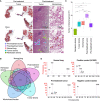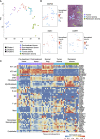Integrated spatial analysis of gene mutation and gene expression for understanding tumor diversity in formalin-fixed paraffin-embedded lung adenocarcinoma
- PMID: 36505794
- PMCID: PMC9731154
- DOI: 10.3389/fonc.2022.936190
Integrated spatial analysis of gene mutation and gene expression for understanding tumor diversity in formalin-fixed paraffin-embedded lung adenocarcinoma
Abstract
Introduction: A deeper understanding of intratumoral heterogeneity is essential for prognosis prediction or accurate treatment plan decisions in clinical practice. However, due to the cross-links and degradation of biomolecules within formalin-fixed paraffin-embedded (FFPE) specimens, it is challenging to analyze them. In this study, we aimed to optimize the simultaneous extraction of mRNA and DNA from microdissected FFPE tissues (φ = 100 µm) and apply the method to analyze tumor diversity in lung adenocarcinoma before and after erlotinib administration.
Method: Two magnetic beads were used for the simultaneous extraction of mRNA and DNA. The decross-linking conditions were evaluated for gene mutation and gene expression analyses of microdissected FFPE tissues. Lung lymph nodes before treatment and lung adenocarcinoma after erlotinib administration were collected from the same patient and were preserved as FFPE specimens for 4 years. Gene expression and gene mutations between histologically classified regions of lung adenocarcinoma (pre-treatment tumor in lung lymph node biopsies and post-treatment tumor, normal lung, tumor stroma, and remission stroma, in resected lung tissue) were compared in a microdissection-based approach.
Results: Using the optimized simultaneous extraction of DNA and mRNA and whole-genome amplification, we detected approximately 4,000-10,000 expressed genes and the epidermal growth factor receptor (EGFR) driver gene mutations from microdissected FFPE tissues. We found the differences in the highly expressed cancer-associated genes and the positive rate of EGFR exon 19 deletions among the tumor before and after treatment and tumor stroma, even though they were collected from tumors of the same patient or close regions of the same specimen.
Conclusion: Our integrated spatial analysis method would be applied to various FFPE pathology specimens providing area-specific gene expression and gene mutation information.
Keywords: cancer therapy; drug resistance; formalin-fixed paraffin-embedded specimens; intratumoral heterogeneity (ITH); non-small cell lung cancer (NSCLC); spatial transcriptome; tumor microenvironment; tyrosine-kinase inhibitors (TKIs).
Copyright © 2022 Yamazaki, Hosokawa, Matsunaga, Arikawa, Takamochi, Suzuki, Hayashi, Kambara and Takeyama.
Conflict of interest statement
HK is a founder and shareholder of Frontier Biosystems, Inc., which provides the microdissection punching system. The remaining authors declare that the research was conducted in the absence of any commercial or financial relationships that could be construed as a potential conflict of interest.
Figures





Similar articles
-
Molecular profiling and utility of cell-free DNA in nonsmall carcinoma of the lung: Study in a tertiary care hospital.J Cancer Res Ther. 2021 Oct-Dec;17(6):1389-1396. doi: 10.4103/jcrt.JCRT_99_20. J Cancer Res Ther. 2021. PMID: 34916369
-
A Fast-Tracking Sample Preparation Protocol for Proteomics of Formalin-Fixed Paraffin-Embedded Tumor Tissues.Methods Mol Biol. 2024;2823:193-223. doi: 10.1007/978-1-0716-3922-1_13. Methods Mol Biol. 2024. PMID: 39052222 Free PMC article.
-
Screening for EGFR and KRAS mutations in non-small cell lung carcinomas using DNA extraction by hydrothermal pressure coupled with PCR-based direct sequencing.Int J Clin Exp Pathol. 2013 Aug 15;6(9):1880-9. eCollection 2013. Int J Clin Exp Pathol. 2013. PMID: 24040454 Free PMC article.
-
Histopathological analysis potential for unveiling hormone signaling in endocrine-related tumors.Endocr Oncol. 2024 Aug 29;4(1):e240033. doi: 10.1530/EO-24-0033. eCollection 2024 Jan 1. Endocr Oncol. 2024. PMID: 39246627 Free PMC article. Review.
-
Sequence-Based Characterization of Intratumoral Bacteria-A Guide to Best Practice.Front Oncol. 2020 Feb 21;10:179. doi: 10.3389/fonc.2020.00179. eCollection 2020. Front Oncol. 2020. PMID: 32154174 Free PMC article. Review.
References
-
- Khozin S, Blumenthal GM, Jiang X, He K, Boyd K, Murgo A, et al. . U.S. food and drug administration approval summary: Erlotinib for the first-line treatment of metastatic non-small cell lung cancer with epidermal growth factor receptor exon 19 deletions or exon 21 (L858R) substitution mutations. Oncologist (2014) 19(7):774–9. doi: 10.1634/theoncologist.2014-0089 - DOI - PMC - PubMed
LinkOut - more resources
Full Text Sources
Research Materials
Miscellaneous

